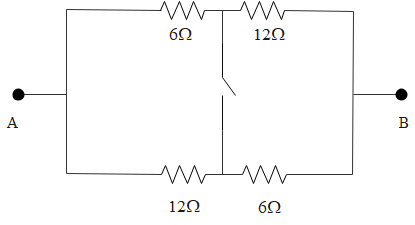
The ratio of equivalent resistance across A and B when switch is open to that when switch is closed is:

(A) $ \dfrac{3}{8} $
(B) $ \dfrac{5}{8} $
(C) $ \dfrac{7}{8} $
(D) $ \dfrac{9}{8} $

Answer
570.3k+ views
Hint
We know that the equivalent resistance is where the aggregate resistance connected either in parallel or series is calculated. More resistance means less current is flowing through the circuit. Equivalent resistance is a different way of indicating total resistance, which we calculate differently for series and parallel circuits. In a series circuit, the different components are connected in a single, continuous loop. However, if we had a huge and complicated circuit with many resistors, then the effective resistance is the total resistance of the circuit. Effective resistance is usually measured between 2 points. Based on this concept we have to solve this question.
Complete step by step answer
We can see from the question that,
When switch is open:
$ 6 \Omega $ and $ 12 \Omega $ are connected in series and $ 12 \Omega $ and $ 6 \Omega $ are also connected in series and both these are in parallel connection. So,
$ \mathrm{R}_{\mathrm{AB}}=(6+12) \|(12+6) $
$ \Rightarrow {{\text{R}}_{\text{AB}}}=18\|18=9\Omega $
When switch is closed:
$ 6 \Omega $ and $ 12 \Omega $ are connected in parallel and $ 12 \Omega $ and $ 6 \Omega $ are also connected in parallel and both these are in series connection.
So, $ \text{R}_{\text{AB}}^{\prime }=[6\|12]+[12\|6] $
Or, $ 6 \| 12=\dfrac{6 \times 12}{6+12}=4 \Omega $
Or, $ \text{R}_{\text{AB}}^{\prime }=4+4=8\Omega $
The Ratio can be calculated as,
$ \dfrac{{{\text{R}}_{\text{AB}}}}{\text{R}_{\text{AB}}^{\prime }}=\dfrac{9}{8} $
Therefore, the correct answer is Option (D).
Note
We know that in a series circuit, the output current of the first resistor flows into the input of the second resistor; therefore, the current is the same in each resistor. In a parallel circuit, all of the resistor leads on one side of the resistors are connected together and all the leads on the other side are connected together. As more and more resistors are added in parallel to a circuit, the equivalent resistance of the circuit decreases and the total current of the circuit increases. Adding more resistors in parallel is equivalent to providing more branches through which charge can flow. In a series circuit, the effective resistance is equal to the sum of the resistances of individual components. So total resistance will be on the higher side. In parallel circuit, reciprocal of effective resistance is equal to sum of reciprocals of individual resistances. So effective resistance is less.
We know that the equivalent resistance is where the aggregate resistance connected either in parallel or series is calculated. More resistance means less current is flowing through the circuit. Equivalent resistance is a different way of indicating total resistance, which we calculate differently for series and parallel circuits. In a series circuit, the different components are connected in a single, continuous loop. However, if we had a huge and complicated circuit with many resistors, then the effective resistance is the total resistance of the circuit. Effective resistance is usually measured between 2 points. Based on this concept we have to solve this question.
Complete step by step answer
We can see from the question that,
When switch is open:
$ 6 \Omega $ and $ 12 \Omega $ are connected in series and $ 12 \Omega $ and $ 6 \Omega $ are also connected in series and both these are in parallel connection. So,
$ \mathrm{R}_{\mathrm{AB}}=(6+12) \|(12+6) $
$ \Rightarrow {{\text{R}}_{\text{AB}}}=18\|18=9\Omega $
When switch is closed:
$ 6 \Omega $ and $ 12 \Omega $ are connected in parallel and $ 12 \Omega $ and $ 6 \Omega $ are also connected in parallel and both these are in series connection.
So, $ \text{R}_{\text{AB}}^{\prime }=[6\|12]+[12\|6] $
Or, $ 6 \| 12=\dfrac{6 \times 12}{6+12}=4 \Omega $
Or, $ \text{R}_{\text{AB}}^{\prime }=4+4=8\Omega $
The Ratio can be calculated as,
$ \dfrac{{{\text{R}}_{\text{AB}}}}{\text{R}_{\text{AB}}^{\prime }}=\dfrac{9}{8} $
Therefore, the correct answer is Option (D).
Note
We know that in a series circuit, the output current of the first resistor flows into the input of the second resistor; therefore, the current is the same in each resistor. In a parallel circuit, all of the resistor leads on one side of the resistors are connected together and all the leads on the other side are connected together. As more and more resistors are added in parallel to a circuit, the equivalent resistance of the circuit decreases and the total current of the circuit increases. Adding more resistors in parallel is equivalent to providing more branches through which charge can flow. In a series circuit, the effective resistance is equal to the sum of the resistances of individual components. So total resistance will be on the higher side. In parallel circuit, reciprocal of effective resistance is equal to sum of reciprocals of individual resistances. So effective resistance is less.
Recently Updated Pages
Master Class 12 English: Engaging Questions & Answers for Success

Master Class 12 Economics: Engaging Questions & Answers for Success

Master Class 12 Social Science: Engaging Questions & Answers for Success

Master Class 12 Maths: Engaging Questions & Answers for Success

Master Class 12 Chemistry: Engaging Questions & Answers for Success

Master Class 12 Business Studies: Engaging Questions & Answers for Success

Trending doubts
What are the major means of transport Explain each class 12 social science CBSE

Which are the Top 10 Largest Countries of the World?

Draw a labelled sketch of the human eye class 12 physics CBSE

Explain sex determination in humans with line diag class 12 biology CBSE

The pH of the pancreatic juice is A 64 B 86 C 120 D class 12 biology CBSE

Explain sex determination in humans with the help of class 12 biology CBSE




